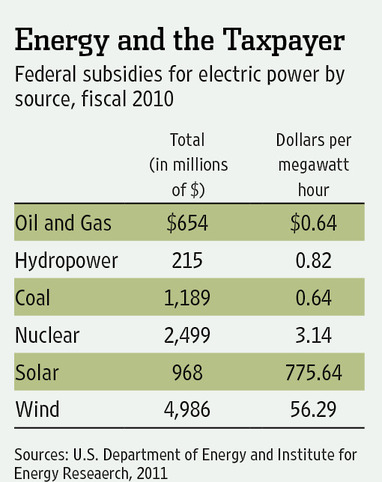Germany once prided itself on being the “photovoltaic world champion”, doling out generous subsidies—totaling more than $130 billion, according to research from Germany’s Ruhr University—to citizens to invest in solar energy. But now the German government is vowing to cut the subsidies sooner than planned and to phase out support over the next five years. What went wrong?
Subsidizing green technology is affordable only if it is done in tiny, tokenistic amounts. Using the government’s generous subsidies, Germans installed 7.5 gigawatts of photovoltaic capacity last year, more than double what the government had deemed “acceptable.” It is estimated that this increase alone will lead to a $260 hike in the average consumer’s annual power bill.
According to Der Spiegel, even members of Chancellor Angela Merkel’s staff are now describing the policy as a massive money pit. Philipp Rösler, Germany’s minister of economics and technology, has called the spiraling solar subsidies a “threat to the economy.”
Germany’s enthusiasm for solar power is understandable. We could satisfy all of the world’s energy needs for an entire year if we could capture just one hour of the sun’s energy. Even with the inefficiency of current PV technology, we could meet the entire globe’s energy demand with solar panels by covering 250,000 square kilometers (155,342 square miles), about 2.6 percent of the Sahara Desert.
Unfortunately, Germany—like most of the world—is not as sunny as the Sahara. And, while sunlight is free, panels and installation are not. Solar power is at least four times more costly than energy produced by fossil fuels. It also has the distinct disadvantage of not working at night, when much electricity is consumed.
In the words of the German Association of Physicists, “solar energy cannot replace any additional power plants.” On short, overcast winter days, Germany’s 1.1 million solar-power systems can generate no electricity at all. The country is then forced to import considerable amounts of electricity from nuclear power plants in France and the Czech Republic.
Indeed, despite the massive investment, solar power accounts for only about 0.3 percent of Germany’s total energy. This is one of the key reasons why Germans now pay the second-highest price for electricity in the developed world (exceeded only by Denmark, which aims to be the “world wind-energy champion”). Germans pay three times more than their American counterparts.
Moreover, this sizeable investment does remarkably little to counter global warming. Even with unrealistically generous assumptions, the unimpressive net effect is that solar power reduces Germany’s CO2 emissions by roughly 8 million metric tons—or about 1 percent – for the next 20 years. To put it another way: By the end of the century, Germany’s $130 billion solar panel subsidies will have postponed temperature increases by 23 hours.
Using solar, Germany is paying about $1,000 per ton of CO2 reduced. The current CO2price in Europe is $8. Germany could have cut 131 times as much CO2 for the same price. Instead, the Germans are wasting more than 99 cents of every euro that they plow into solar panels.
It gets worse: Because Germany is part of the European Union Emissions Trading System, the actual effect of extra solar panels in Germany leads to no CO2 reductions, because total emissions are already capped. Instead, the Germans simply allow other parts of the EU to emit more CO2. Germany’s solar panels have only made it cheaper for Portugal or Greece to use coal.
Defenders of Germany’s solar subsidies also claim that they have helped to create “green jobs.” But each job created by green-energy policies costs an average of $175,000—considerably more than job creation elsewhere in the economy, such as infrastructure or health care. And many “green jobs” are being exported to China, meaning that Europeans subsidize Chinese jobs, with no CO2 reductions.
Germany’s experiment with subsidizing inefficient solar technology has failed. What governments should do instead is to focus first on increasing research and development to make green-energy technology cheaper and more competitive. Production should be ramped up later.
In the meantime, Germans have paid about $130 billion for a climate-change policy that has no impact on global warming. They have subsidized Chinese jobs and other European countries’ reliance on dirty energy sources. And they have needlessly burdened their economy. As even many German officials would probably attest, governments elsewhere cannot afford to repeat the same mistake.





















